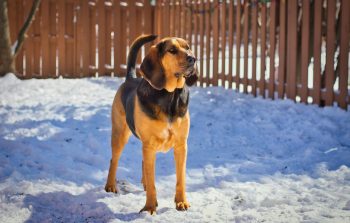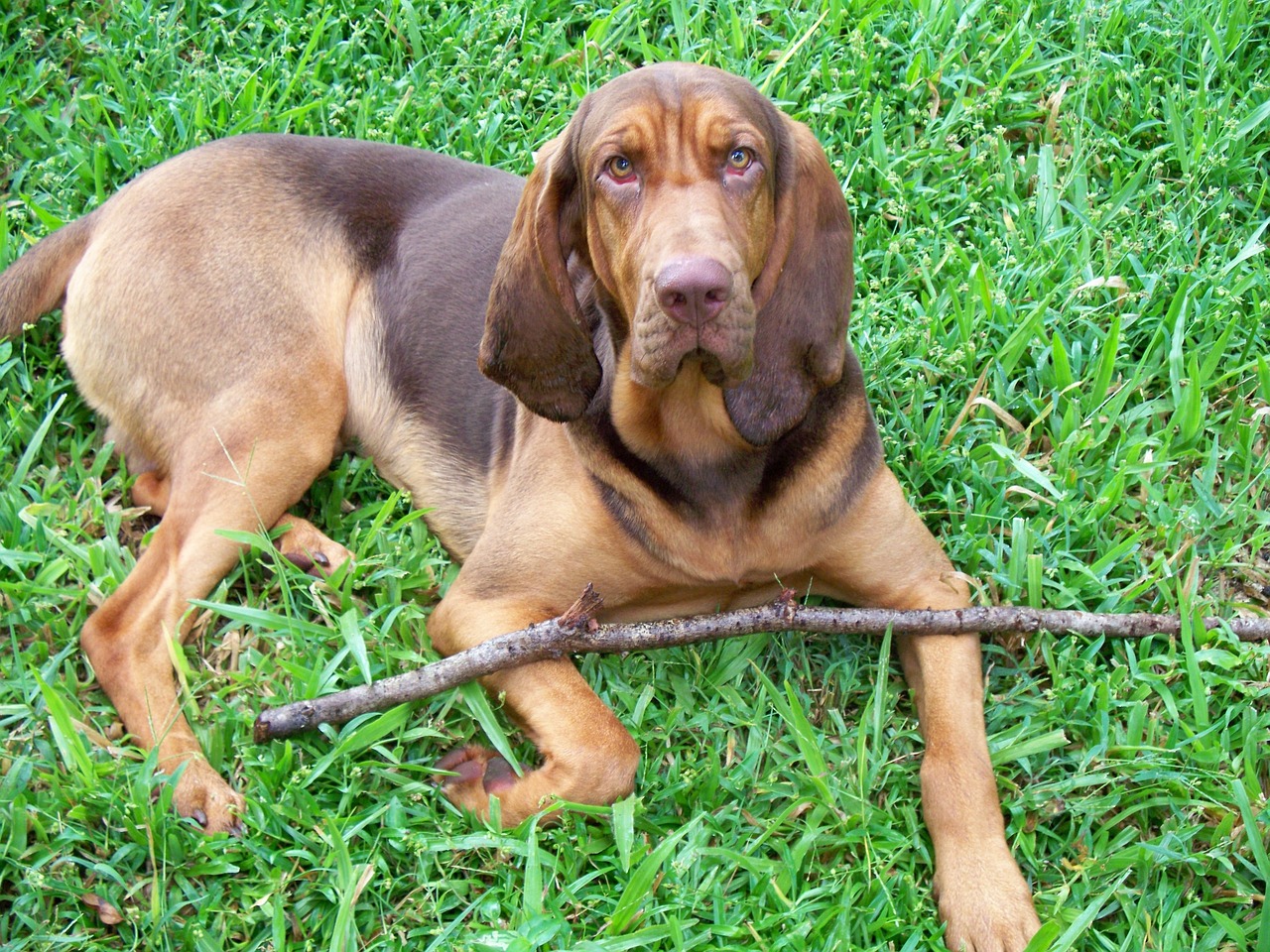
Bloodhounds are renowned for their incredible sense of smell and tracking abilities, making them one of the most recognizable scent hounds. With their long, drooping ears and solemn eyes, they have a distinctive appearance that complements their serious work ethic. Bloodhounds are employed in search and rescue missions, and law enforcement, and are valued as loyal family pets. Despite their size and slobber, their gentle nature and patience make them excellent companions. Several breeds share these commendable qualities for those fascinated by the Bloodhound’s unique traits but curious about similar breeds—whether for their tracking skills, demeanor, or physical characteristics. This article explores 10 dog breeds similar to Bloodhounds, focusing on their abilities, temperament, and suitability as working dogs and companions.
1. Basset Hound
Basset Hounds, with their distinctive long ears and melancholy expressions, share the Bloodhound’s excellent scenting abilities and calm demeanor. Bred for hunting small game, Basset Hounds are smaller but equally tenacious on the trail. Their short legs and long body give them a unique appearance, while their gentle, friendly nature makes them great family pets. Bassets are known for their patience and affinity with children, making them a more manageable alternative for those charmed by the Bloodhound’s traits.
2. Coonhound
Coonhounds, a breed developed in the United States, share the Bloodhound’s keen sense of smell and tracking abilities. There are several types of Coonhounds, including the Black and Tan, Bluetick, and Redbone, each distinguished by their coat pattern. Coonhounds are versatile hunters that can track a wide range of game, from raccoons to deer. They are known for their endurance, speed, and loud, melodic bay. Coonhounds are sociable, and adaptable, and make loyal family pets.
3. Beagle
Beagles are one of the most popular scent hounds, known for their compact size, friendly disposition, and exceptional nose. Similar to Bloodhounds, Beagles are used for tracking but are more suited to hunting small game like rabbits. They are energetic, curious, and enjoy being part of a pack, whether with other dogs or a human family. Beagles are great with children and make excellent companions for those seeking a smaller, but equally capable, scent hound.
4. Foxhound
Foxhounds, including the American and English varieties, were bred for fox hunting and share many qualities with Bloodhounds, including their tracking ability and stamina. Foxhounds are larger and faster than Beagles but retain the friendly, sociable nature common to scent hounds. They are known for their musical bay, love of the outdoors, and need for ample exercise, making them suitable for active families or those with access to large outdoor spaces.
5. Bassett Fauve de Bretagne
The Basset Fauve de Bretagne is a small French scent hound known for its wiry, fawn-colored coat and enthusiastic tracking ability. While smaller than the Bloodhound, this breed shares the determination and skill to follow a scent trail. The Basset Fauve de Bretagne is lively, and affectionate, and makes an excellent companion for families, providing the joys of a scent hound in a more compact package.
6. Harrier
Harriers, bred for hunting hares and foxes, are medium-sized scent hounds that share the Bloodhound’s pack mentality and love for the chase. They are known for their stamina, good nature, and ability to work both independently and as part of a group. Harriers are friendly and outgoing, making them well-suited to family life, though they require plenty of exercise to satisfy their hunting instincts.
7. Dachshund
Dachshunds, though distinct in appearance with their long bodies and short legs, are skilled scent hounds used for tracking games such as badgers. They share the Bloodhound’s keen nose and persistence on the trail. Dachshunds are courageous, curious, and known for their spunky personality, making them a popular choice for those seeking a small but fearless companion with tracking abilities.
8. Otterhound
Otterhounds are large, rare scent hounds originally bred for hunting otters. They share the Bloodhound’s excellent nose and love of water, with a rough, double coat that protects them in harsh conditions. Otterhounds are amiable, boisterous, and possess a unique bay. Their laid-back personality and strength make them great companions, though their rarity can make them difficult to find.
9. Plott Hound
The Plott Hound, the state dog of North Carolina, is a powerful scent hound known for tracking large game, including bears and boar. Plotts share the Bloodhound’s tracking prowess and tenacity but are more agile and quicker. They are loyal, and intelligent, and make excellent guard dogs, with a strong protective instinct towards their family.
10. Saint Hubert Jura Hound
The Saint Hubert Jura Hound, less known but closely related to the Bloodhound, is a Swiss scent hound used for tracking games in the Jura Mountains. They share the Bloodhound’s exceptional nose and determination, with a similarly calm and friendly temperament. The Saint Hubert Jura Hound is adaptable, gentle with children, and makes a loyal family pet for those interested in a rare but capable scent hound.
While the Bloodhound is unparalleled in its tracking abilities and distinctive appearance, several breeds offer similar qualities that make them appealing to enthusiasts of scent hounds. From the compact Beagle to the rare Otterhound, each breed provides an alternative for those seeking a loyal companion with a nose for adventure. Whether drawn to their tracking skills, their sociable nature, or their unique looks, there’s likely a breed among these ten that will capture the hearts of those who admire the noble Bloodhound.
What Are Bloodhounds Like? How Are They Different Than Other Breeds?

Bloodhounds are one of the most distinctive and oldest breeds of dogs known for their remarkable tracking abilities. With their noble and solemn appearance, drooping ears, and wrinkled skin, they have been immortalized in popular culture as the quintessential detective dog. Beyond their work in tracking and law enforcement, Bloodhounds are gentle, affectionate companions known for their loyalty and patience. This article explores the unique characteristics of Bloodhounds, their temperament, how they compare to other breeds, and what makes them such beloved pets and invaluable working dogs.
Understanding Bloodhounds
Bloodhounds possess a striking appearance, characterized by their large size, loose skin, and long, drooping ears that help capture scent particles from the ground. They have a short coat that comes in colors like black and tan, liver and tan, or red. A distinguishing feature of Bloodhounds is their incredible sense of smell, which is among the best of any dog breed, allowing them to follow trails over great distances and even days later.
Temperament and Behavior
Despite their imposing size, Bloodhounds are known for their gentle and affectionate nature. They are exceptionally patient, making them excellent companions for children. Their demeanor is calm and friendly, but they can be shy around strangers, showcasing a reserved but never aggressive temperament. Bloodhounds are happiest when given a job to do, especially scent work, which engages their instincts.
Physical Characteristics
Bloodhounds are large, powerful dogs, with males standing 25 to 27 inches at the shoulder and females slightly smaller. Their build is sturdy and muscular, designed for endurance rather than speed. The skin is loose and hangs in folds around the head and neck, enhancing their ability to pick up scents. Their eyes are deep-set and have a soft, pleading expression, adding to their distinctive look.
How Are They Different Than Other Breeds?
Bloodhounds are unparalleled in their tracking ability, a trait that sets them apart from other breeds. While many dogs have a keen sense of smell, Bloodhounds’ olfactory capabilities are so advanced that their tracking results are admissible as evidence in court. Unlike many breeds that may excel in agility or obedience, Bloodhounds are specialists in scent work, with a single-minded focus when on a trail. Their combination of physical and sensory attributes, along with their temperament, makes them unique among working dogs.
Health and Care
Bloodhounds have a lifespan of 10 to 12 years and are generally healthy but can be prone to certain genetic conditions such as hip dysplasia, bloat, and ear infections due to their long, droopy ears. Regular veterinary check-ups, a healthy diet, and proper exercise can help manage these risks. Their coat requires minimal grooming, but their ears need regular cleaning to prevent infections, and the folds in their skin may require special attention to keep them clean and dry.
Bloodhounds in Society
Bloodhounds have a long history of service, originally bred for hunting deer and boar. Today, they are more commonly used in search and rescue missions and law enforcement to track missing persons or fugitives. Their gentle nature also makes them excellent therapy dogs. Despite their working abilities, Bloodhounds are beloved family pets, known for their loyalty and affectionate bond with their owners.
Bloodhounds are a breed like no other, combining unparalleled scenting abilities with a gentle, loving temperament. While they may require more specialized care, particularly in managing their health and grooming needs, the rewards of owning a Bloodhound are immeasurable. They offer not only the companionship and loyalty found in all dogs but also bring a sense of purpose and ability that is uniquely their own. For families, individuals, or professionals seeking a dedicated working dog or a loyal companion, the Bloodhound stands out as a breed that embodies the best of both worlds.
The post 10 Dog Breeds Similar to Bloodhounds appeared first on iHeartDogs.com.
via Whisker Therapy